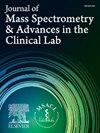建立一种同位素稀释气相色谱-质谱法测定人血清中葡萄糖的候选参考方法
IF 3.4
4区 医学
Q2 MEDICAL LABORATORY TECHNOLOGY
Journal of Mass Spectrometry and Advances in the Clinical Lab
Pub Date : 2025-04-01
DOI:10.1016/j.jmsacl.2025.04.005
引用次数: 0
摘要
糖尿病是美国第七大死因,影响了超过3700万人。准确的血糖测量对有效的糖尿病管理至关重要。一种可靠的候选参考测量程序(cRMP)用于评估在患者护理中进行的葡萄糖测试的分析性能,对于确保测量准确性至关重要。方法建立了以气相色谱-质谱(GC-MS)为基础的血清葡萄糖定量分析方法。在这个过程中,葡萄糖被测量为乙腈乙酸酯衍生物,并使用13c6 -葡萄糖内标进行定量。结果通过色谱分离和监测样品的定量/确认离子比,实现了分析选择性。来自美国国家标准与技术研究所(NIST)和美国国家实验室(LNE)的8个水平的血清认证标准物质的偏倚范围为- 0.79%至0.67%,在低、中、高葡萄糖浓度水平下的总cv分别为1.11%、0.68%和0.74%,cRMP提供了极好的准确度和精密度。在13.51 ~ 378.21 mg/dL [0.75 ~ 21 mmol/L]测量范围内,校准曲线呈线性关系(R2 = 0.9999),平均斜率为270.73 (95% CI, 270.19 ~ 271.27),截距为0.021 (95% CI, - 0.157 ~ 0.199)。检测限为0.25 mg/dL (0.014 mmol/L),定量限为0.83 mg/dL (0.046 mmol/L)。结论所建立的气相色谱-质谱联用方法可溯源至国际单位制(SI),对人血清中葡萄糖的测定具有较高的准确度和精密度。本文章由计算机程序翻译,如有差异,请以英文原文为准。
Development of an isotope dilution gas chromatography − mass spectrometry candidate reference measurement procedure for glucose in human serum
Introduction
Diabetes is the seventh leading cause of death in the United States, impacting over 37 million people. Accurate glucose measurements are critical for effective diabetes management. A reliable candidate reference measurement procedure (cRMP) for assessing the analytical performance of glucose tests performed in patient care is essential for ensuring measurement accuracy.
Methods
We have developed a gas chromatography-mass spectrometry (GC–MS)-based cRMP for glucose in human serum. In this procedure, glucose is measured as the aldononitrile acetate derivative and quantitated using a 13C6-glucose internal standard.
Results
Analytical selectivity was achieved through chromatographic separation and monitoring the quantitation ion/confirmation ion ratios in samples. With bias ranging from −0.79 % to 0.67 % for eight levels of serum-based certified reference materials from the National Institute of Standards and Technology (NIST) and Laboratoire national de métrologie et d’essais (LNE) and total CVs of 1.11 %, 0.68 % and 0.74 % at the low, medium, and high glucose concentration levels, respectively, the cRMP provided excellent accuracy and precision. The calibration curve was linear throughout the 13.51–378.21 mg/dL [0.75–21 mmol/L] measurement range (R2 = 0.9999), with a mean slope of 270.73 (95 % CI, 270.19 to 271.27) and an intercept of 0.021 (95 % CI, −0.157 to 0.199). The limit of detection was 0.25 mg/dL (0.014 mmol/L) and the limit of quantitation was 0.83 mg/dL (0.046 mmol/L).
Conclusion
The described GC–MS method, with metrological traceability to the International System of Units (SI), provides highly accurate and precise measurements of glucose in human serum.
求助全文
通过发布文献求助,成功后即可免费获取论文全文。
去求助
来源期刊

Journal of Mass Spectrometry and Advances in the Clinical Lab
Health Professions-Medical Laboratory Technology
CiteScore
4.30
自引率
18.20%
发文量
41
审稿时长
81 days
 求助内容:
求助内容: 应助结果提醒方式:
应助结果提醒方式:


